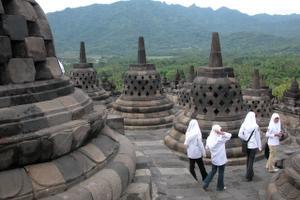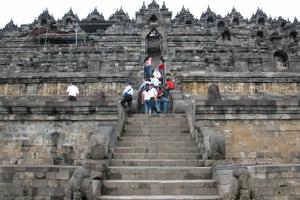Last December, the Beetle visited Indonesia. Apart from diving I took a trip to Java from Sulawesi and saw the Borobodur Temple (amongst other things). I stayed a few days in Yogyakarta, a name I shall forever have problems pronouncing and hired a car and driver for US 30 for the day which seemed a pretty efficient way of getting around. Much to the initial annoyance of my driver, we gave lifts to anyone (especially older people) carrying huge bundles and had the freedom to stop wherever I fancied and see out of the way things, and some really were out of the way! Mr Azim, my very patient driver looked after me well, as well as driving like he was trying to break the world land speed record and he made Yogyakarta to the Borobodur in just 40 minutes! Using public transport, it is possible to go by bus or minibus from Yogyakarta to the town of Muntilan, change at the terminal here to another bus for Borobudur. Note that the bus station at Borobudur is 1km away from the temple though it is possible to walk. Alternatively, you can go on one of many guided tours on mini buses to Yogyakarta.
It seemed to be the time of year when schools make their annual school trip outings. There must have been several hundred school children, lounging around, larking about, and taking lots and lots of photos! I found out, by talking with many of the groups that they came mainly from Sumatra and other parts of Java and they were absolutely delightful, as curious about me as I was about them. I got many tips on places to go on my travels and invites to family homes, which was very kind.
This was just one day after the horrific tsunami and there was a muted respect and appreciation for the events that were just starting to unfold, but at the same time, it was a holiday and the school children were having a whale of a time.
The Beetle was pretty much the only non Indonesian visitor on that day and the school children's main task seem to be to detract me from seeing the Borobodur at all, but I didn't mind. It was a lot of fun lining up, arms round the girls' shoulders, smiling broadly for the multitude of cameras that were bought out, just one more, just one more they'd say. And the boys, shyly jostling to see who could stand closest and arms held just above my shoulders, thinking I would not see them or feel them as long as they were not resting on me. They were funny adolescent youngsters. And then there was the name and signature signing in their little notebooks. I thought the whole thing was most odd, but a wonderful way to meet Indonesian people and my entire 4 hours spent there consisted of photo posing, though I got my own back and asked other people to pose for me, notebook signing and having simple English conversations. It was a lot of fun, though I kind of wished I'd had a little more of a chance to see a bit more of the Borobodur!

Ok, about the Borobodur: It is thought to have been built between
the end of the seventh and beginning of the eighth century A.D. For
about a century and a half it was the spiritual centre of Buddhism
in Java and then it was lost until its rediscovery in the
eighteenth century. The temples are set in beautifully manicured
gardens and are said to be composed of 55,000 square meters of
lava-rock is erected on a hill in the form of a stepped-pyramid of
six rectangular storeys, three circular terraces and a central
stupa forming the summit. The whole structure is in the form of a
lotus, the sacred flower of Buddha. For each direction there are
ninety-two Dhyani Buddha statues and 1,460 relief scenes. The
lowest level has 160 reliefs depicting cause and effect; the middle
level contains various stories of the Buddha's life from the
Jataka Tales; the highest level has no reliefs or decorations
whatsoever but has a balcony, square in shape with round walls: a
circle without beginning or end. Here is the place of the
ninety-two Vajrasattvas or Dhyani Buddhas tucked into small stupas.
Each of these statues has a mudra (hand gesture) indicating one of
the five directions: east, with the mudra of calling the earth to
witness; south, with the hand position of blessing; west, with the
gesture of meditation; north, the mudra of fearlessness; and the
centre with the gesture of teaching.

You are supposed to wander around the galleries and terraces always turning to the left and keeping the main structure to the right but I noticed that none of the school children observed this tradition. In total, Borobodur represents the ten levels of a Bodhisattva's life which he or she must develop to become a Buddha or an awakened one.
 Early morning is the best time to visit Javanese temples, Borobudur
included. The gate opens at 6 am, around sunrise. The view of the
surrounding volcanoes and the Bukit Menoreh range to the south is
clearest at dawn, although morning mists sometimes obscure the view
until 8 am. Visitors must walk 500 meters to the base of the hill
then climb a series of steps to reach the temple foot. To see all
the reliefs one must walk more than 2 km (1.25 mile) around the four
galleries and climb several flights of steps. The minimum amount of
time needed at the Site is 1.5 hours.
Early morning is the best time to visit Javanese temples, Borobudur
included. The gate opens at 6 am, around sunrise. The view of the
surrounding volcanoes and the Bukit Menoreh range to the south is
clearest at dawn, although morning mists sometimes obscure the view
until 8 am. Visitors must walk 500 meters to the base of the hill
then climb a series of steps to reach the temple foot. To see all
the reliefs one must walk more than 2 km (1.25 mile) around the four
galleries and climb several flights of steps. The minimum amount of
time needed at the Site is 1.5 hours.
All in all, it was a highly enjoyable day out and I thoroughly recommend it.
